
surfresearch.com.au
contests : world contest, puerto rico, 1968
contests : world contest, puerto rico, 1968
|
|
|
|
|
|
 |
surfresearch.com.au
contests : world contest, puerto rico, 1968 |
| The Surfboards The fourth world contest in Puerto Rico confirmed the ongoing development of smaller surfboards with a corresponding increase in surfing performance. This was a radical change from two years earlier, where boards were invariably longer than 9ft and the US media imagined that noseriding was the ultimate demonstration of progressive wave riding. Following Nat Young's resounding victory in California, Australian surfers continued to reduce the length of their boards and by late 1967 their new wide-tailed v-bottomed designs, and their performance, were a revelation to visiting American surfers representing the Windansea surf club. These new designs were enthusiastically promoted by the Australian surf media and manufacturers, although their limitations were severely tested in Hawaii in the winter season of 1967-1968. However, in Hawaii shapers such as George Downing, Dick Brewer, Joey Cabell and Ben Apia and recognised the advantages of the marked reduction in volume and their pin-tail Guns got progressively smaller, until they became Mini-guns. Back home in Australia, the wide-tailed v-bottom board was suddenly obsolete and was replaced with, usually rounded, pin-tails or small square-tails, commonly known as Trackers. In California, the local media was hesitant to promote Australian success to the detriment of established manufacturers who struggled with these rapid developments, producing both wide-tail and pin-tail models in conservative lengths, On both sides of the Pacific there was a flowering of small custom shops; often beginning with striping and re-shaping a now obsolete board in the family garage. |
 |
The Waves The nomination of Puerto Rico as the world contest venue was highly unusual, undoubtedly the vast majority of competitors were completely unfamiliar with its surfing potential. Furthermore, competitive surfing was largely untested in PR, whereas the previous contests in Australia, Peru and California had well established organisations and years of experience in conducting surfing contests. Based on positive media reports, there was some expectation that the contest would provide large waves to test the competitors' skills, similar to Peru, but in tropical waters, and in contrast to the small wave conditions of Australia and California. Unfortunately, the Caribbean was particularly docile leading up to the contest and through the first rounds, only coming to life on the very last day. As the competition was held almost exclusively in right-hand breaks it was not surprising that all the men's finalists were natural-footers. Unfortunately, the competitors frustration with the lack of swell was compounded by the theft of boards and camera equipment. |
 |
The Media Surfing Magazines The contest featured in Californian and Australian magazines, although the articles did not appear until the beginning of the new year: Surf International, Volume 2 Number 1, January 1969. Paul Carey: World Contest Puerto Rico and Paul Witzig: World Contest Puerto Rico, Note that this magazine often avoided using captions to identify the surfers or locations Surfer, Volume 9 Number 6, January 1969 1968 World Contest Edition International Surfing, Volume 5 Number 1, February-March 1969. 1968 World Contest Television Importantly, the contest was covered by America's ABC Television's Wide World of Sports, which probably screened sometime in December 1968-January 1969. WWS had previously covered the Duke Contest in Hawaii and produced a high quality production in rich colour with a combination of beach, helicopter and water footage. It included the Women's final and the semi-finals and final of the Men's competition. In the introduction, Bill Fleming noted the considerable change in board length in the past year, illustrated by a 10ft board ridden at Makaha and a current sub-8ft board. ABC Wide World of Sports Footage (1969) World Surf Contest 1968 Rincon Puerto Rico: https://www.youtube.com/watch?v=Gy6vTH71izg Mundiales de Surfing 1968 Rincon,Puerto Rico Part 1: https://www.youtube.com/watch?v=Y7Nz3te2Was Film Contest footage appeared in Australian film-maker Paul Witzig's Evolution, released in 1970. Although primarily concentrating on the film's stars Wayne Lynch, Nat Young and Ted Spencer, the Peurto Rico sequence features some pre-contest free surfing, some of the heats and the tandem event, and the final of the World Contest. In particular, note one brief shot of Nat Young and Midget Farrelly sharing a wave. It also appears that "Irish" competitor and film-maker Rod Sumpter included footage from Puerto Rico in With Surfing in Mind, released in 1969. Evolution (1970) Trailer: https://vimeo.com/272393954 World surfing contest 1968 rincon PR: https://www.youtube.com/watch?v=1Y8CvPW76LQ THE WORLD SURFING CHAMPIONSHIP 1968 RINCON PR: https://www.youtube.com/watch?v=T9YfC4i8cZs |
  |
| Semi Final 1 1. Fred Hemmings (H- Green) 2. Russell Hughes (A- Orange) Also: Wayne Lynch (A-Black), David Nuuihwa (WC-White), George Thomson (SA-Yellow). Hemmings is a clear winner, while goofy's Lynch and Nuuihwa are disadvantaged riding backhand, David losses his board and has a low wave count. Semi Final 2 1. Nat Young (A-Black) 2. Reno Abellira (H-Green) Also: Skip Frye (WC-White), Pete Johnson (WC-Yellow), Alan Byrne (NZ-Orange). Young scores a very rare left and is a clear winner, while Al Byrne is disadvantaged riding backhand. Semi Final 3 1. Midget Farrelly (A - Black) 2. Mike Doyle (WC- Yellow) Also Corky Carroll (WC - Orange), Joey Cabell (H-Green), Mike Purpus (WC - White). Doyle losses his board but manages to score some good waves, but Farrelly is the clear winner and comments "We're, lucky, versatile, and don't give up easily." After breaking his fin on a rock, Cabell is seen riding Nuiihwa's board and, like the other goofys, Carroll is disadvantaged, losses his board and has a low wave count. In 2011 Corky Carroll recalled his performance in the contest. The comments are based on ABCWWS TV footage. |
 World Champions:
Fred Hemmings and Margo Godrey |
|
MEN
1. Fred Hemmings - Hawaii 2. Midget Farrelly - Australia 3. Russell Hughes - Australia 4. Nat Young - Australia 5. Mike Doyle - California 6. Reno Abellira - Hawaii |
WOMEN 1. Margo Godfrey - California 2. Sharron Weber - Hawaii 3. Phyllis O'Donnell - Australia 4. Martha Sunn - Hawaii 5. Candy Chase - Puerto Rico 6. Janice Domorski - East Coast |
TANDEM 1. Ron Ball-Debbie Gustafon - California 2. Dr. Robert Scott-Liz Herd - California & East Coast 3. Rodney Sumpter-Annete Hughes - Ireland & England 4. Fred Hemmings-Leslie Scott - Hawaii & California 5. Mike Doyle-Margo Godfrey - California |
5000 METER PADDLING
RACE 1st: West Coast USA Bill Mount, Kenny Linn, Jerry Bennette, Mike Doyle. 2nd: Australia Midget Farrelly, Ted Spencer, Peter Drouyn, Nat Young. |
| SOURCES Dutch Vandervoort: Puerto Rico Discovered (cover photo) Surfing June 1968 Volume 1 Number 2  Californian
transplant, Dutch Vandervoort, Rincon.
|
 Californian Greg
Tucker, Jobos.
|
 |
| A number of international
competitors arrived at the San Juan airport
on 2 November 1968 where Duline McGough, a surfer-paddler
from California,
photographed a pile of about a dozen surfboards
recently unloaded, and none in board bags. There is considerable variation in lengths and a range of fin designs, with the shorter boards in the foreground. In the foreground, the black-railed pintail may have a WaveSet-type fin and box and the very short blue board possibly Reno Abellira's Le Serpent (?). See: History of Women's Surfing https://hwsurf.smugmug.com/United-States/1968-World-Surfing-Contest/i-dxZJGVc http://www.historyofwomensurfing.com/duline-mcgough/ And also see (HWS Director) Sheri Crummer: My First surf Trip, 1968. http://www.historyofwomensurfing.com/my-first-surf-trip/ |
Please
click for image.
Boards at the airport, San Juan. Puerto Rico, 2 November 1968. Photo: Duline McGough |
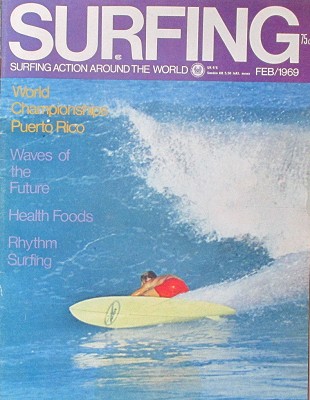 |
Photographs: Surfing Volume 1 Number ? February 1969. Cover: Mike Doyle, Hansen Surfboards. Doyle was the big wave reserve on the Californian team. Joey Cabell, Semi Final 3, World Contest, Domes, Puerto Rico, November 1968. page 27 |
 |
Paul Witzig: Surf
International, v2n2. [Midget Farrelly]
 [Unknown, bottom turn.] |
 [Midget Farrelly and ... Wally Froiseth and George Downing?] 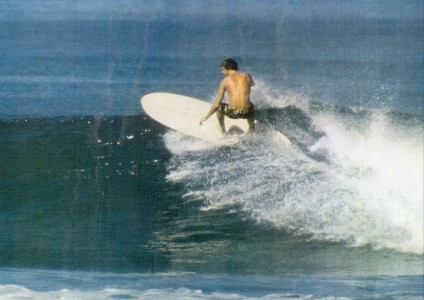 [Nat Young top turn.] |
Doug
Fiske: The Blink of an Eye - https://oneblinkofani.blogspot.fr/ Wayne Lynch, Domes, Puerto Rico 1968. |
 Joyce Hoffman, Domes, Puerto Rico 1968. |
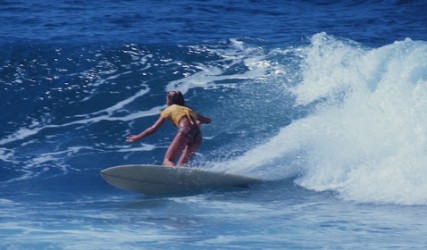 Margo Godfrey, Domes, Puerto Rico 1968. |
 Fred Hemmings, Rincon, Puerto Rico, 1968. Photo: David Singletary. |
 |
Nat Young and
Ski, Puerto Rico, November 1968. Nat (far left) in pith helmet and
Ski, 1968 World Contest
Final.
 Other
Finalists:
Mike Doyle, Russell Hughes, Fred
Hemmings,
Midget (hidden behind Eduardo) and Reno. ABC-TV footage |

Russell
Hughes, Puerto Rico, November 1968.
|
 Keith
Paull, Domes, Puerto Rico 1968.
Photo: Barry Church |
Midget
Farrelly: World contest semi-final.
ABC-TV footage |
 |
 |
 |
 |
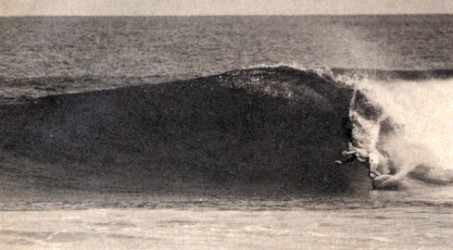 Mike Purpus out of an "S" turn. |
|
 David Nuuihwa faces left gas |
 Skip Frye, Domes/Rincon. (photo Grannis?) |

|
Mickey Gose (&?): International
Surfing
 |
1968 World Championships Edition
Volume 5 Number 1, February-March 1969.  Fred
Hemmings and Midget Farrelly tied for first
place,
but the Hawaiian was declared the winner by including an extra wave. |
 |
 |
 |
 |
 |
 |
 |
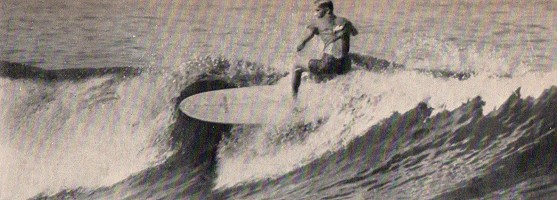 |
 |
 |
 |
 |
 |
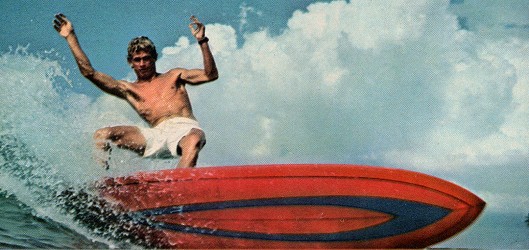 |
 |

 |
 |
 |
 |
|
AND:
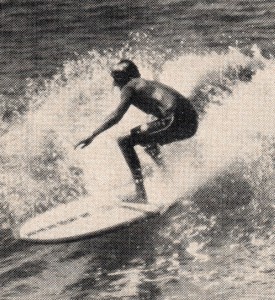 Mike Doyle turning into a hot section. |
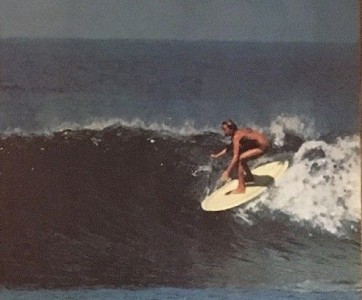 Margo Godfrey, Puerto Rico (Surfer Poll: July 1969) |
| World Contest Surfboard
Dimensions Most of these dimensions are roughly estimated from photographs and film; the longest board appears to be Fred Hemmings' 8ft 6''. Australia Midget Farrelly: 8 ft? pintail, Midget Farrelly Surfboards, red bottom with blue foil, yellow deck and red rails. Russell Hughes: 8 ft? square-tail, shaped by Bob McTavish, yellow. Keith Paull: 7ft 10"?, The Foil by Bing Surfboards, red bottom and white deck. Shaped at Michael Barrland Surfboards, France: Nat Young: +7 ft round tail, clear with three glue-lines and hand painted decal: The Young Weber. Ted Spencer: +7ft round tail, clear with glue-line stringers. Wayne Lynch: +7ft round tail, clear with glue-line stringers. Hawaii Fred Hemmings: 8ft 6", Greg Noll Surfboards shaped by Ben Apia, red with yellow deck, fin box and moulded fin. Ben Apia : +8ft, Greg Noll Surfboards, red bottom and rails, yellow deck Joey Cabell: 8 ft? pintail, clear with down rails. Reno Abellira: Le Serpent mini-gun by Dick Brewer?, blue with light blue deck, down rails. 6ft 7" x 18.75" x 2.6" single glassed round-pin, weighing 8 lbs, including the fin. California Mike Doyle : +8ft pintail, Hansen Surfboards, blue rails and white deck, fin box and moulded fin Skip Frye: +7ft? square-tail, Gordon and Smith Surfboards, yellow with a green nose patch. David Nuuihwa: 7 ft 8"? pintail, red with white-blue deck and ying-yang logo, down rails? And Unknown - riding standing on what looks like a blue 5 ft knee-board (???) |
 |
|
Through the
preliminaries and quarter finals I
had no problems getting through at
all. (The semi-final ...) was a 30-minute heat. I started out with three very good scores and was confident that I was winning the heat. My forth wave came at about the 16-minute mark. It was a very long wall and I had a solid score going (but in going for) a big "fly away" kickout (the following wave) took my board before I could get to it. By the time I reached the beach to retrieve it the heat was over and I only had four waves. I still had the highest four scores but my total left me within a point of advancing to the finals. Midget and Doyle advanced and I took third. Soooo close, yet no gold. - Corky Carroll’s Surf’s Up column: 1968 World Surfing Championship one for the ages Orange County Register, Sept. 25, 2011, viewed January 2012. http://www.ocregister.com/articles/wave-318917-surfing-going.html |
 Corky
Carroll, Cottons Point.
|
| An East Coast
View Rod Rogers identified himself in Beach Crowd at Domes and in a page devoted to the 1968 World Contest recalled his days in Puerto Rico: I spent most of the semi-finals and finals surfing 2nd Rock at Maria's Point with the surf in the 8-12' range. Mostly rode my Paipo-60, but also spent some time on a friend's McTavish V-Bottom. and We grommets didn't care too much for the California group, nor for Fred Hemmings. They all seemed so constipated on their long boards and went about town with an inflated sense of self-importance. David Nuuwiha and Reno Abellira rocked on down-the-line speed and the Aussies were lot's of fun with their progressive approach to wave riding and friendly dispostion --they also would loan us groms their boards! Drew Kampion captured these feelings correctly in his coffee table book, Stoked! Rod Rodgers: 1968 World Contest Rincon, Puerto Rico, November 5-14, 1968 http://www.rodndtube.com/surf/rpts/pr1968/pr1968.shtml |
 |
| |
|
|
|
|
|
|